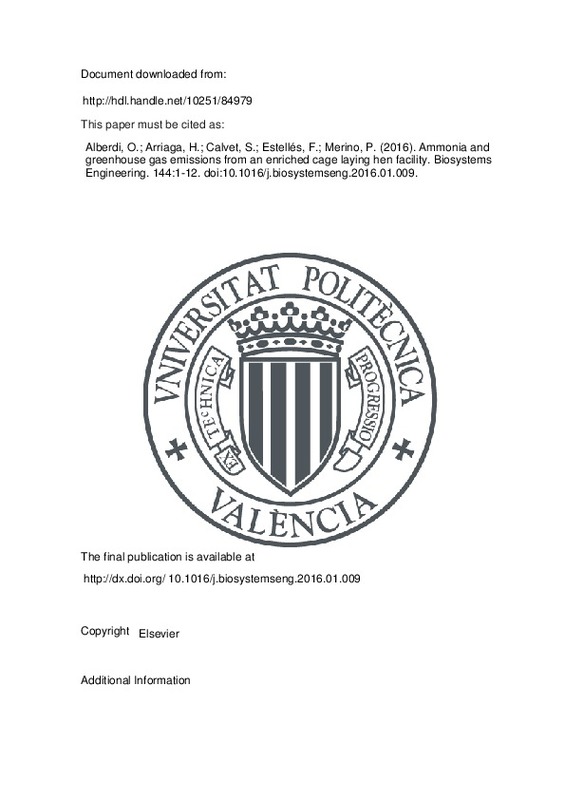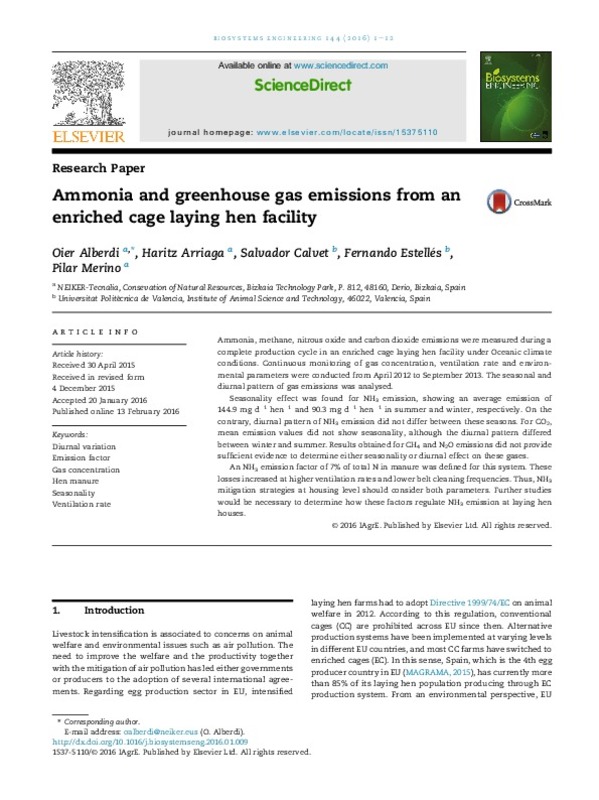JavaScript is disabled for your browser. Some features of this site may not work without it.
Buscar en RiuNet
Listar
Mi cuenta
Estadísticas
Ayuda RiuNet
Admin. UPV
Ammonia and greenhouse gas emissions from an enriched cage laying hen facility
Mostrar el registro sencillo del ítem
Ficheros en el ítem
| dc.contributor.author | Alberdi, O.
|
es_ES |
| dc.contributor.author | Arriaga, H.
|
es_ES |
| dc.contributor.author | Calvet, S.
|
es_ES |
| dc.contributor.author | Estellés, F.
|
es_ES |
| dc.contributor.author | Merino, Pilar
|
es_ES |
| dc.date.accessioned | 2017-07-12T07:07:22Z | |
| dc.date.available | 2017-07-12T07:07:22Z | |
| dc.date.issued | 2016-04 | |
| dc.identifier.issn | 1537-5110 | |
| dc.identifier.uri | http://hdl.handle.net/10251/84979 | |
| dc.description.abstract | [EN] Ammonia, methane, nitrous oxide and carbon dioxide emissions were measured during a complete production cycle in an enriched cage laying hen facility under Oceanic climate conditions. Continuous monitoring of gas concentration, ventilation rate and environmental parameters were conducted from April 2012 to September 2013. The seasonal and diurnal pattern of gas emissions was analysed. Seasonality effect was found for NH3 emission, showing an average emission of 144.9 mg d 1 hen 1 and 90.3 mg d 1 hen 1 in summer and winter, respectively. On the contrary, diurnal pattern of NH3 emission did not differ between these seasons. For CO2, mean emission values did not show seasonality, although the diurnal pattern differed between winter and summer. Results obtained for CH4 and N2O emissions did not provide sufficient evidence to determine either seasonality or diurnal effect on these gases. An NH3 emission factor of 7% of total N in manure was defined for this system. These losses increased at higher ventilation rates and lower belt cleaning frequencies. Thus, NH3 mitigation strategies at housing level should consider both parameters. Further studies would be necessary to determine how these factors regulate NH3 emission at laying hen houses. © 2016 IAgrE. Published by Elsevier Ltd. All rights reserved | es_ES |
| dc.description.sponsorship | This work has been funded by BATFARM Interreg-Atlantic Area Project (2009-1/071) entitled "Evaluation of best available techniques to decrease air and water pollution in animal farms". Oier Alberdi holds a grant from the Ph.D. student's research program of the Department of Economic Development and Competitiveness of the Basque Government. The authors are especially grateful to Larrabe Oilotegia S.A.T. that facilitated productive data and access to the farm and to the engineering company Ingenieria Avicola S.L. for the detailed information on ventilation aspects of the installation. | en_EN |
| dc.language | Inglés | es_ES |
| dc.publisher | Elsevier | es_ES |
| dc.relation | This work has been funded by BATFARM Interreg-Atlantic Area Project (2009-1/071) entitled "Evaluation of best available techniques to decrease air and water pollution in animal farms". Oier Alberdi holds a grant from the Ph.D. student's research program of the Department of Economic Development and Competitiveness of the Basque Government. The authors are especially grateful to Larrabe Oilotegia S.A.T. that facilitated productive data and access to the farm and to the engineering company Ingenieria Avicola S.L. for the detailed information on ventilation aspects of the installation. | es_ES |
| dc.relation.ispartof | Biosystems Engineering | es_ES |
| dc.rights | Reconocimiento - No comercial - Sin obra derivada (by-nc-nd) | es_ES |
| dc.subject | Diurnal variation | es_ES |
| dc.subject | Emission factor | es_ES |
| dc.subject | Gas concentration | es_ES |
| dc.subject | Hen manure | es_ES |
| dc.subject | Seasonality | es_ES |
| dc.subject | Ventilation rate | es_ES |
| dc.subject.classification | PRODUCCION ANIMAL | es_ES |
| dc.title | Ammonia and greenhouse gas emissions from an enriched cage laying hen facility | es_ES |
| dc.type | Artículo | es_ES |
| dc.identifier.doi | 10.1016/j.biosystemseng.2016.01.009 | |
| dc.relation.projectID | info:eu-repo/grantAgreement/EC//2009-1%2F071/EU/Evaluation of best available techniques to decrease air and water pollution in animal farms/BATFARM/ | es_ES |
| dc.rights.accessRights | Abierto | es_ES |
| dc.contributor.affiliation | Universitat Politècnica de València. Escuela Técnica Superior de Ingeniería Agronómica y del Medio Natural - Escola Tècnica Superior d'Enginyeria Agronòmica i del Medi Natural | es_ES |
| dc.contributor.affiliation | Universitat Politècnica de València. Instituto de Ciencia y Tecnología Animal - Institut de Ciència i Tecnologia Animal | es_ES |
| dc.description.bibliographicCitation | Alberdi, O.; Arriaga, H.; Calvet, S.; Estellés, F.; Merino, P. (2016). Ammonia and greenhouse gas emissions from an enriched cage laying hen facility. Biosystems Engineering. 144:1-12. doi:10.1016/j.biosystemseng.2016.01.009 | es_ES |
| dc.description.accrualMethod | S | es_ES |
| dc.relation.publisherversion | http://dx.doi.org/ 10.1016/j.biosystemseng.2016.01.009 | es_ES |
| dc.description.upvformatpinicio | 1 | es_ES |
| dc.description.upvformatpfin | 12 | es_ES |
| dc.type.version | info:eu-repo/semantics/publishedVersion | es_ES |
| dc.description.volume | 144 | es_ES |
| dc.relation.senia | 314005 | es_ES |
| dc.identifier.eissn | 1537-5129 | |
| dc.contributor.funder | European Commission | es_ES |
| dc.contributor.funder | Eusko Jaurlaritza |









